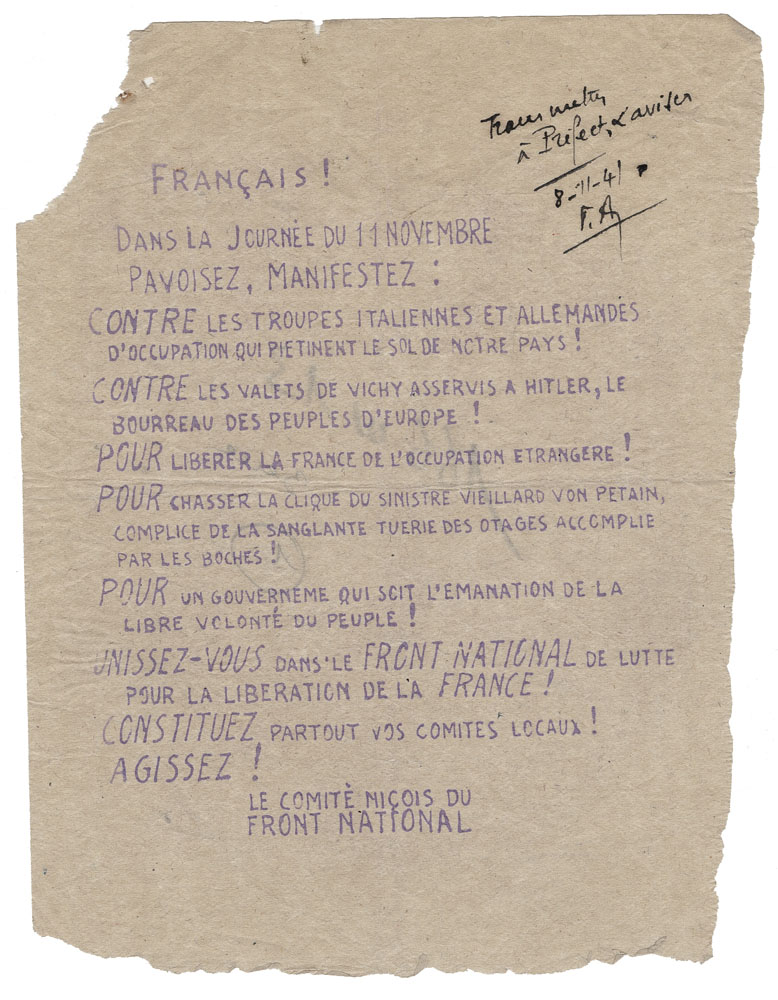Papillon FN appelant à manifester le 11 novembre 1941
Légende :
Papillon de la section niçoise du Front National appelant à manifester le 11 novembre 1941
Sticker from the Nice Section of the National Front Calling for Protests to be held on November 11th, 1941
Genre : Image
Type : Tract
Source : © ADAM 166 W 13 Droits réservés
Détails techniques :
Petit format sur papier pelure.
Date document : Novembre 1941
Lieu : France - Provence-Alpes-Côte-d'Azur - Alpes-Maritimes - Nice
Analyse média
Ce papillon ronéotypé sur du papier pelure est le premier diffusé par le comité niçois du Front national de lutte pour l'indépendance de la France. Il appelle la population niçoise à manifester lors de l'anniversaire de l'armistice de 1918 contre la présence des occupants italiens et allemands, mais aussi contre les hommes de Vichy (qualifiés de "valets asservis à Hitler" et de "clique du sinistre vieillard von Pétain"), tout en réclamant un gouvernement démocratique.
L'utilisation de papier pelure ou de papier sulfurisé de boucher atteste des difficultés à se procurer du papier standard à des fins de propagande.
This sticker, printed on onion skin paper was first printed by the Nice committee of the National Front for the fight for French independence. It calls upon the people of Nice to protest during the anniversary of the armistice of 1918 against the presence of the Italian and German occupants as well as the Vichy government (calling the members “servants to Hitler” and “the clique to the evil old man, Von Pétain”) all in reclaiming the need for a democratic government.
The use of onion skin paper or sulfurized paper used normally by butchers is an example of the scarcity of paper at the time as much as the resourcefulness of the Résistance in their propaganda campaign.
Jean-Louis Panicacci
Traduction : Sarah Buckowski
Contexte historique
Les mouvements de résistance appellent, dès 1941, les patriotes à manifester à l'occasion du 14 juillet et du 11 novembre, fêtes emblématiques de la nation française marginalisées par le régime de Vichy, inquiet de débordements patriotiques et germanophobes. Ici, un autre événement justifie la démarche de la mouvance communiste, l'exécution de 27 otages (parmi lesquels 25 militants du PCF) à Châteaubriant le 22 octobre 1941.
The Résistance movements made a call to the public starting in 1941 for fellow patriots to take to the streets and protest on July 14th and November 11th, both emblematic holidays for France but since marginalized by the Vichy government which greatly feared any patriotic or anti-German misbehaviors. The execution of 27 hostages (25 of them being Communists activists) in Châteaubriant on October 27th 1941 being another instance justified by the steps taken by the communist movement to take up protest.
Jean-Louis Panicacci, La Résistance azuréenne, Nice, Serre, 1994.
Joseph Girard, La Résistance et la libération de Nice, Nice, Serre, 2006.
Traduction : Sarah Buckowski



 Voir le bloc-notes
()
Voir le bloc-notes
()